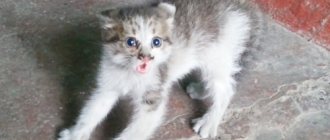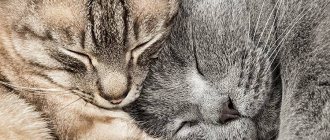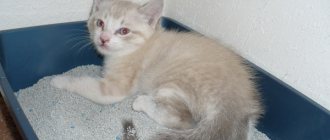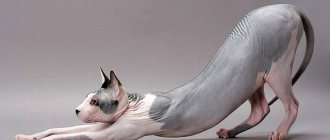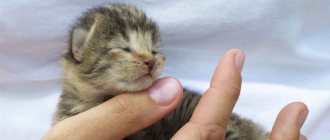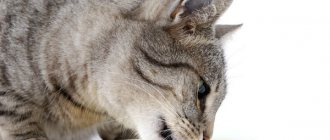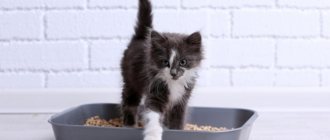The small domestic leopard is a Bengal cat, born as a result of crossing Asian wild and common domestic cats. These cats are quite friendly and peaceful, but do not forget about their opposite side.
This is the first moment that you will have to face when raising a small animal - Bengals have a difficult character, so you will need to find an approach to it, and you need to do this exclusively with affection and love.
The Bengal cat is not too large, the height at the withers is on average 32 cm, weight is about 7 kg, females are slightly smaller. The body is strong, muscular, slightly elongated. The limbs are elongated and strong.
These cats perfectly combine the features of a domestic cat and a wild cat; they are smart, cunning, careful, very active and graceful. Some may think that they are too unsociable, but this is not entirely true. They are wary of new people and watch from some hiding place, but they show enough attention and affection to their owners.
Bengals are quite friendly with all family members and can find a common language with other animals, but you should know that this cat needs its own territory, which it will consider as its own and protect, satisfying its natural instincts.
This breed is distinguished from others by its love of conversation. Bengals, unlike their counterparts, love to talk with people, and they do this in various ways: along with simple meowing, they use a lot of other sounds.
Socialization of kittens
Knowing how to raise a Bengal kitten, you will never encounter his aggression. It is when hunting that the tailed “child” can be sharp (he is excellent at catching mice). But the pet will get accustomed to the family pretty quickly. Interestingly, raising such a cat is not particularly difficult. These creatures are very smart and observant, so they learn many useful skills from people with interest.
Socialization of the kitten takes place without unnecessary problems. True, the animal, as a rule, treats family members, including children, differently (more precisely, the cat chooses one owner). A pet can watch its pet for hours, it does not like to let it out of its sight.
Character
Keeping Bengals in enclosures leads to their rapid wilding. But in a pack they feel great. If it is possible to take two kittens, this will be a good option for them. The Bengal cat, contrary to rumors, is not aggressive or even bloodthirsty. He gets along well with children and poses no danger to them. Only rodents and birds should be afraid of it.
When raising small Bengal kittens, it is necessary to accustom them to handling from the first day. Then they will become affectionate friends, but otherwise wild animals.
These cats are quite smart and quick-witted. They easily learn to open doors and even flush the toilet. Like their wild cousins, Bengals have a special love for water. However, this does not mean that they swim in the bathtub, or even dive. They like running water. In this case, you can watch the splashes and catch them with your paw.
Cats of this breed become very attached to their owner and become dependent on humans. They love to engage in conversations, as they have a fairly wide range of different sounds in their arsenal.
Another interesting character trait of Bengals is their love of water. Animals of this breed, contrary to prejudices that cats are afraid of moisture, enjoy swimming and taking baths.
If a Bengal cat has to get into a fight, its behavior is different from other breeds. Bengals do not rush at the enemy head-on, but wait for the moment when he turns his back to him, and pounce from behind - an echo of wild origin.
Representatives of this breed have a lot of advantages, but it is worth understanding that it is impossible to accurately state and attribute any character traits to all Bengal cats. Each animal is unique, but some advantages specific to this particular breed can still be highlighted.
- Lack of aggressiveness and contact. As a rule, Bengals get along well with children and get along well with other pets.
- Adequacy and intelligence. Bengal cats rarely get into fights with stronger opponents. They prefer to avoid such clashes.
- Love of bathing. Owners will have no problems if the need arises to bathe their pet.
- Courage. Bengal cats actively guard and defend their territory from strangers. These animals are difficult to scare.
- Ability to learn. Animals of this breed are very capable, they can even be taught some tricks (for example, flushing the toilet or turning off the light in the room).
- Good qualities of mousecatchers. Hunting instincts play a good role when fighting rodents.
Speaking about shortcomings, we can say that they arise from character strengths.
- The animal's activity allows it to be playful, but at the same time, left alone for a long time, the Bengal can make a big mess.
- Attachment to the owner makes the Bengal cat a loyal friend, but the animal is not able to remain alone for a long time and does not tolerate when the owner does not have time for him.
- The independence of cats makes them not entirely tame. Bengals love to be on an equal footing with humans, but they don't particularly like being cuddled or picked up frequently.
What are the benefits of training a Bengal cat?
There are many benefits to training a Bengal cat and no downsides other than the time and effort involved. Training your Bengal cat is a great way to channel your intelligence and curiosity into productive activities.
Training is a great activity for both you and your cat. It's an easy way to spend one-on-one time with a common goal in mind. Your cat will enjoy the focus and attention, and you will feel relieved to know that your cat is well-behaved around the house.
For highly intelligent animals like the Bengal cat, they need stimulation throughout the day to keep them from getting bored. Teaching them tricks allows them to channel their intelligence in a constructive manner rather than through destructive behavior.
Feeding
Keeping adult Bengal cats is, first of all, a balanced diet. Not many owners of cats of this breed feed them natural products. It is recommended to give preference to dry food mixtures, which should be purchased in pet stores, but not in supermarkets. Such formulations not only contain various vitamins in the required quantities, but also carefully care for the health of your pet’s gums and teeth.
Kittens do not always digest dry food well (some may even develop allergies). In this case, buy wet food (canned food). If you switched your Bengal cat to exclusively natural products, make sure that the animal receives not only food, but also vitamins. Oats or chalk - your pet will chew all this with pleasure.
Related article: Common and rare diseases of British cats
Bengal cat oral hygiene
We understand that most people probably don't pay much attention to their cat's oral hygiene. However, your cat's dental health is not something that should be so easily ignored; Your cat is just as susceptible to oral infections as you are.
To prevent these infections, you must regularly monitor your cat's oral hygiene. While some people simply look into their cat's mouth from time to time, others prefer to brush their cat's teeth.
Of course, they don't just use any old toothpaste or toothbrush to get the job done. Yes, they make toothpaste and toothbrushes for cats (and dogs). Not only do you need to buy oral care products specifically formulated for cats, but you also need to make it easier to clean your cat's teeth.
Some cat owners, for example, start brushing their cat's teeth with their fingers and gradually begin using toothbrushes instead of their fingers. The idea of using your fingers to probe a cat's mouth may seem disgusting, but if you love your Bengal cat, we feel you'll make the sacrifice.
Catering rules
Until the age of one month, babies, as a rule, are fed only breast milk. After 4–5 weeks, new foods begin to be introduced into the diet. This could be a scraped chicken breast, scalded with boiling water. A little later it will be veal, beef or turkey cut into small pieces. Add porridge with eggs to your diet. Be sure to include raw and boiled vegetables: carrots, pumpkin, beets, broccoli, cauliflower.
Keep in mind that at the age of 8–9 months, a cat’s weak point is the stomach (diarrhea often occurs). Experts recommend feeding animals very carefully and choosing premium food:
- Husse;
- Grandorf;
- Acana;
- Royal Canin;
- Orijen;
- Fitmin (grain-free).
The packaging must indicate that the food is intended for feeding kittens. Pay attention to the age recommendations on the packaging. Some kittens have individual intolerances and skin allergies - in this case, purchase hypoallergenic formulations.
Consider the physical activity of Bengals. For neutered cats with a tendency to obesity, low-calorie recipes are suitable. Try not to give such economical options as Felix and Whiskas.
There should always be fresh water in the bowl, which should be changed 1-2 times a day.
What proponents of natural nutrition should know:
- 80% of the diet should be meat, the best option is beef without fat.
- 10–15% – edible bones: neck, joints, cartilage (except tubular).
- 5–10% – tripe: chicken heart, stomach, lung.
- You can also give chicken, rabbit, and veal as meat.
- The meat is first frozen and served raw.
- You can sometimes feed them boiled pieces.
- Liver is given rarely and little by little.
- Pork and lamb are prohibited for Bengals.
- You cannot offer hot or cold food.
- Cats are given boiled, boneless sea fish; cats do not need fish.
- Healthy dairy products include kefir, fermented baked milk, and cream.
To breed “little leopards” and have healthy offspring, take care of vitamins and minerals. A veterinarian will help you make the right choice.
Natural diet
If the owner wants to provide a Bengal cat with a natural diet, he must be prepared for additional troubles: developing a detailed menu for the week and month, frequent visits to the veterinary pharmacy, and keeping a pet’s food diary.
Basic and additional healthy foods of the diet
The Bengal cat's menu must include:
- meat, meat products constituting 50-60 percent of the total diet: poultry, veal, rabbit (duck, pork, lamb should not be given), as well as offal of these same animals - heart, stomach, liver, lungs;
- dairy products in their fermented milk versions (up to 20 percent of the entire menu) - cottage cheese, kefir, fermented baked milk, sour cream - all with three to five percent fat content;
- vegetables: carrots, zucchini, cabbage, pumpkin, cucumber, beets, raw or boiled - 20 percent;
- cereals as an addition should not exceed 5-10 percent of the entire menu; oats (cereal flakes), buckwheat, rice are suitable;
- raw egg yolks (preferably quail) give 1-2 per week.
Food is not salted during preparation. Porridge can be given with meat products. It is important to know: with natural feeding, the diet of a Bengal cat most likely will not contain absolutely all the necessary vitamins and microelements. They need to be replenished with the help of supplement complexes, purchasing special chalk, adding olive oil and fish oil to food. All this should be purchased only in specialized pet stores.
There is no exact answer to the question of how much a Bengal cat eats. Large and very active pets may ask to eat more often and more. There are observations that a cat does not drink water if it is not fresh enough. He can even show character - for example, indignantly, turn over a bowl of water. Flow-through special fountains are the best option.
What would you like to add to the menu?
Even if the cat does not eat natural meat, it is useful to give your Bengal cat raw chicken white cartilage from chicken breasts, separating them from the bones. Whole pre-frozen day-old chicks can be offered. It is highly advisable to add cooked chicken necks as an additive. The recipe is simple:
- free from skin;
— scroll through a meat grinder (grind to a paste);
— Freeze the resulting minced paste in portions.
This supplement is useful for everyone, but is especially necessary for growing Bengals, that is, young animals up to two years old.
What is excluded from the menu.
In addition to the fact that all cats are prohibited from eating potatoes and eggplants due to the lack of the appropriate enzymes for breaking down potatoes, Bengal cats are not recommended to eat legumes (peas, corn, beans are difficult to digest, promote gas formation), whole fresh milk, especially cow's milk. Contrary to beliefs, it is better not to give fish and seafood to representatives of this breed or not to do it often - only a small number of times a week is permissible, no more (pollock and similar varieties of low-fat sea fish are suitable).
Bengals of any age are strictly prohibited from:
- bones - in addition to the fact that the animal can choke, solid particles damage the esophagus, stomach, and clog the intestines;
- fatty, fried, spicy (peppered, salted, smoked) foods - disrupt metabolism and cause upset of the entire gastrointestinal tract;
- all sweets that weaken the immune system, disrupt metabolism, and lead to dental diseases (chocolate containing theobromine, which is poisonous to cats, is especially dangerous, causing severe poisoning, even the death of a Bengal cat);
- medicines, even vitamins made for humans - having its own special balance of substances in the body, the cat can be poisoned, the animal’s kidneys can fail, which will lead to death.
Care
Providing complete care for a breed called a Bengal cat is a whole set of recommendations that need to be taken into account. Knowing how to care for a Bengal kitten from a young age, you will not worry about the health of your pet in the future (for example, the risk of allergies will noticeably decrease). What rules are required to be followed?
Behind the ears
Care and maintenance of your Bengal begins with regular cleaning of the ears. They often accumulate dust and sulfur, which must be removed in a timely manner. To do this, use ear sticks that are pre-moistened in a special solution. Do this procedure regularly, and the health of your Bengal's ears will be in perfect order.
Behind the wool
Many people strive to breed such cats because of their main advantage - the stunningly beautiful color of their coat. But what’s interesting is that special coat care is not required. It is enough to purchase special cosmetics that will give the fur smoothness and shine. Every few days, use a rubber or metal comb to run through your Bengal's coat.
However, you don’t need to comb it too often - the pet’s fur is short, and it rarely sheds.
Behind the teeth
In order for the breeding of these cats to be successful, it is very important to be able to provide proper care for them. Pay special attention to the dental health of your Bengal cats. They do not require special cleaning. The main thing is not to skimp on products. If you purchase high-quality feed mixtures, then nothing will threaten your dental health.
Behind the claws
First of all, buy a special scratching post. It is necessary because the Bengal cat loves to sharpen its claws. If this is not done, she will find another alternative that is not very pleasant for you (a soft sofa or chair, wallpaper or carpet). Therefore, having a scratching post is mandatory from the moment a kitten appears in your apartment. Another important point in caring for your nails: trim them once a week. To do this, it is advisable to use a special nail clipper.
Similar article: How to organize food for a kitten and an adult Maine Coon
Care and maintenance
An exotic and expensive breed, oddly enough, does not require special care. Like other pets, they require good nutrition and some hygiene procedures. They don’t need to be brushed daily; they don’t need expensive care cosmetics either. It is enough to follow simple rules of care.
Basic rules of care
- Pets have special fur. It is short and silky. Cats shed lightly and do not need to be brushed. They take care of their fur themselves. During seasonal shedding, it is enough to remove dead hairs with a rubber glove.
- Bengals are rarely bathed. The procedure will bring a lot of positive emotions, because water is almost a native element for this breed.
- An active cat usually grinds its claws down on its own. It is necessary to install a scratching post for him. Inspect the claws once a week, and if necessary, cut off their dead part with special nippers.
- Eyes should always be clean. The accumulated secretion in the corners is removed with a piece of clean cloth.
- Ears are regularly cleaned of wax and dust with cotton swabs. During the procedure, a special product is used.
Origin of the breed
The Asian leopard cat, the Bengal, has the grace and flexibility characteristic of many predators. External features of a purebred pet:
- Wedge-shaped head with a large chin.
- Wide nose, slightly curved.
- Very beautiful almond-shaped eyes. Color – golden or rich green.
- Chubby cheeks with attractive pads.
- The ears are set high and short in size with a noticeable rounding at the tips.
- Muscular long neck.
- Strong body of large size.
- Small tail, fairly dense structure.
- Powerful paws, rounded at the base. The forelimbs are slightly shorter in length than the hind legs.
- Soft silky coat, hypoallergenic, short length with a shiny sheen. Thick in texture with dense undercoat. Has no tendency to shed.
The cat of this breed is large and quite impressive in size. Females reach 5 kg, the average weight of males is 7 kg. The coat color of Bengal cats can be any shade, with the exception of aquamarine and blue.
Mandatory condition for color: uniform distribution of distinct oval-shaped spots throughout the body of the animal, black or dark brown. The exception is the black Bengal cat, which has uniformly colored charcoal-colored fur.
The most popular coat colors for Bengals are:
- leopard, spotted;
- rosette on gold - golden coat color with brownish spots;
- marbled color, has spots on the coat, but with an unusual distribution and non-standard shape;
- rosette on silver - wool with a silver tint and dark spots;
- snow leopard is gray and white with dark spots (the snow Bengal cat is born pure white, and over time characteristic spots appear on the body).
An interesting variety of the breed is the fold-eared Bengal cat, whose appearance is somewhat reminiscent of a Scotsman. It is of natural leopard origin, but instead of having short ears with rounded tips, representatives of this variety have the tips of their ears drooping, creating an unusual appearance.
Bengals have an interesting character. Some consider this breed to be aggressive, associating the domestic cat with predators, but this is not the case. In fact, the pet’s character contains only good traits. Bengal cats are affectionate and friendly, loving attention and care.
They have a well-developed hunting instinct and intelligence. Cats will never go where it might be dangerous. In this they are helped by developed precautions and incredible intelligence.
Bengal cats are very loyal to their owners and quickly get used to their home environment. A cute pet often behaves like a faithful and devoted dog, follows on the heels of its owner and rejoices like a child if the owner shows attention and care.
Purebred kittens are very playful and active, and even as they grow up, they continue to show an active character and enthusiastically spend time in outdoor games with other family members. If there are other pets in the house, the Bengal will quickly make friends with the “neighbor”. They are not afraid of dogs and easily build friendly relationships even with dogs of fighting breeds.
Bengal cats love heights. They will happily nestle on the top shelf of the closet and watch what is happening in the house from above. But they need a high position not only as an observation point. For Bengals, such a platform is an excellent place for jumping.
If you do not want to catch interior items from the top shelves of furniture items, try to remove everything valuable and fragile from visible places, since during active jumping the cat can catch things standing nearby. These disadvantages of the animal's character are easily eliminated by proper upbringing.
Better yet, buy a special installation with a ladder for your pet. It will replace not only the empty cabinet shelves in the house, but also the curtains and curtains that the Belgian representative loves to ride on.
Reading this description of the Bengal breed, many begin to give up the idea of having a leopard pet because of its restless nature. But there is no need to get scared ahead of time. This breed is distinguished by its unsurpassed intelligence and intelligence, so proper upbringing can teach the kitten good manners. They can be trained and taught different commands. An intelligent and loyal cat will be happy to carry out the owner’s instructions and learn new tricks.
Bengal cats inherited from their predatory descendants a love of water and bathing. This quality is unusual for domestic cats, who are wary of such procedures. With a Bengal, everything is much simpler; the cute pet will happily sit next to the water tap and play with the flowing liquid. Bathing is successful, the pet loves to swim in the bath and splash in the water with its beloved owner.
If you do not want to share the bathing procedure with your pet cat, close the bathroom door while bathing, as a cat of this breed will jump into your water without hesitation. Well, they can’t resist such pleasure!
Bengal cats love attention and do not tolerate loneliness well. It is not recommended to have such an animal for busy people who do not have the opportunity to devote enough time and attention to their pet. This is an interesting characteristic of Bengal cats.
The domestic Bengal cat was bred in the second half of the last century. We owe the appearance of this artificial breed to the American geneticist biologist Jean Mill. This persistent woman spent two decades before she was able to demonstrate her handiwork at the TICA Championship. On this long journey there were successes, failures, and a long break in work.
The first individuals bred were cautious, distrustful, and did not make contact. They preferred a solitary lifestyle, although they did not show aggression. More than once, Jean Mill brought wild representatives of the original breed from the southeast of the Asian continent or took wild representatives of the original breed from the zoo and crossed them with domestic cats. The first was the female Malaysia, then the Bengal cat Delhi and so on. Gradually, patience and perseverance revealed to the world a gentle miracle in a leopard fur coat.
Nowadays, the already popular breed is becoming more and more in demand. People come to the Bengal nursery and learn about the nature of the charming animals, their care, and nutrition. An important issue is also resolved here - the price of a Bengal cat.
Reasons for the lack of desire to go to the owner's arms
Psychologists in the field of zoology draw attention to the fact that cats have a number of reasons why they do not want to sit in their owner’s arms. This is especially true for those who already have an adult cat living in their home.
It is much more difficult to accustom an adult cat to being handled than a small kitten. Cats that live outside for a long time are difficult to train, and also do not understand why the owner wants the animal to sit quietly in his arms. Having received everything it needs - water and food, the cat goes for a walk about its business.
Experts identify a number of main reasons why an animal does not want to be held:
- Lack of balance and solid support. Most members of the feline family, including domestic cats, do not like it when they do not feel balanced, being in a state of weightlessness. The animal accepts the situation with caution, being at the height of human growth.
- Fear of heights. Paradoxically, many cats are simply afraid of heights. Raising a cat to the height of his height, a person does not understand that the animal is simply afraid of falling.
- Psychological trauma. A cat picked up on the street or adopted from a shelter will treat all new relationships with caution and distrust. Cats have an excellent memory, and if an animal was previously treated cruelly, it will remember this for a long time, trying to avoid possible stressful situations and potential danger.
- Strong odors. Cats don't like strong smells. Therefore, if the owner’s hands smell of something harsh and unpleasant (for example, washing powder, hand cream, perfume), the animal will flatly refuse to sit on the hands. A delicate sense of smell simply will not allow your pet to fully relax in your arms.
- Character traits. Some cat breeds potentially love freedom, and become terribly nervous if they are limited in this freedom. Such pets prefer solitude and rarely rub around their owner, demanding affection and attention. The most striking example of independence among cat breeds are the British and Scots.
How to educate and toilet train
Raising these feline babies is an important process for their owner. First of all, the kitten needs to be toilet trained. This is not always easy to do, since these creatures are so squeamish that they sometimes refuse to even visit their litter box. To avoid this problem, buy wood filler for the toilet. If even after this the “Bengal” does not want to go to the litter box and relieves himself in another place, sprinkle the surface with table vinegar or citrus fruits, and your pet will not appear there again.
Raising your tailed pet is simply necessary. Spend more time with him as he has a very playful personality. It is important that the “Bengali” has his own toys, otherwise he will catch and start having fun with everything he comes across, right down to your clothes.
Remember: it is necessary to teach the cat the “No!” command in a timely manner.
To do this, first combine a verbal command with lightly pinching the kitten's neck. However, do not try to hit him - violence will not help your pet understand what you want from him. When walking, try to put a harness around the cat's neck. You need to accustom him to a leash from an early age, then he will not behave nervously during walks.
Common diseases and vaccinations
Adult Bengal cats are prone to diseases. Most often they present with diseases associated with the gastrointestinal tract. However, the list of common ailments also includes cardiomyopathy and flat chest syndrome. Allergies are no exception for Bengalis. To reduce the risk of developing certain diseases, do not neglect vaccinating your pet. The first vaccination is done in the nursery.
Your main task is to adhere to the vaccination schedule in the future. Remember: any disease can be detected at an early stage, which means you can get rid of it sooner. Bring your Bengal cat to the veterinarian for a check-up at least once a year. At the first symptoms, a specialist will provide the animal with the necessary medical care.
Related Article: Overview of the Celtic or European Shorthair Cat Breed
Video “What you need to know about the Bengal cat”
From this video you will learn about how the Bengal cat breed appeared, how to care for and feed it.
Recommended Posts
Standard height and weight of the Cane Corso breed by month
Weight of a puppy and an adult Labrador by month
Description and content of the hunting border terrier
Weight and height of a German Shepherd puppy by month
Description and care of the highly intelligent Border Collie breed
Description of forms and features of treatment of enteritis in cats
Intelligence
When talking about the features and character of Bengal cats, it is important to note their intelligence. Representatives of this breed have the instincts and cunning of their predatory ancestors, the highest adaptability, intelligence and intelligence. Bengals are very attentive and observant, capable, like dogs, of remembering and following commands.
This domestic cat with the appearance of a mini-leopard very sensitively captures all the nuances of the owner’s mood and strives with all her might to correct him, attracting him to her pranks and games.
History of the breed
The Bengal cat is a hybrid of a domestic cat with a wild Bengal cat (Prionailurus bengalensis) as a result of the work of phenolenologists. In the 1960s, American scientist Jane Mill brought a wild Bengal cat from Taiwan to Arizona. Either she wanted to save a wild animal in this way (the species was threatened with complete extermination), or she simply decided to buy it as a souvenir.
In the house of an American woman, a small leopard accidentally “became friends” with a domestic cat, resulting in the birth of offspring. This is how the idea of creating a breed with the appearance of a leopard and the character of a domestic cat arose.
In 1963, Jane brought a representative of the wild species from Asia for breeding work and bred it with the American Shorthair. But in 2 litters, the males were born sterile, but wild females with domestic cats gave birth to offspring capable of reproduction.
The work was long. But she was crowned with success. For a very long time, Bengals were not recognized by any phenological association because of their wild ancestors. But in the 80s they finally got to the exhibition, where they created a sensation. And in 1991, the breed was recognized and given official status.




